Erté’s theatrical costume designs reflected the spirit of lavish spectacle and indulgence in escapism typical of the era of “decadence.” Interestingly, Erté actually wore his own designs. “I am very fond of masked balls,” he admitted, “and I love dressing myself in costumes created by me and for myself, personally.”
Coming off of Victorian era clothing, Hollywood would likely never have gotten its reputation for glitz, starlight and glamour if it wasn’t for Erte and the special vision he had of women. Before Erte, women were stuck in Victorian Era clothing: corsets, button up boots, voluminous skirts, high neck collars. Erte, a Russian Artist, had a special view of women. The way Erte looked at women, drew them, envisioned them, sculpted them, indicated his vision of defining the power of the female form, the hourglass shape, the elegance of length and accessorization; femininity without the ridiculous…..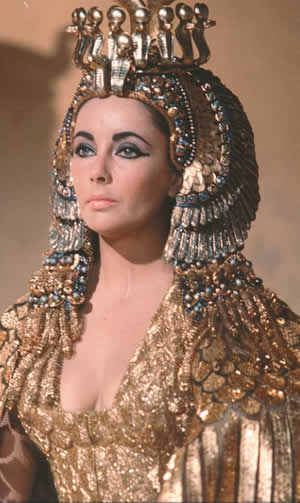
His art deco designs, arrangements of clothing, color and environments, and the long, tall and cool roaring twenties style, were instrumental in the movement to see women as equal, beautiful and special. He defined the elegance of Hollywood, nightclubs, adult womanhood, and haute couture. Censorship was very strict in the early days of Hollywood, but Erte’s designs and overall look enabled costume designers to create profoundly sexy, incredibly feminine and unimaginably gorgeous costumes for the greatest and most beautiful actresses, movies and roles- still unmatched on all those scores.
Few can boast a 100-year career. Erte, as Romain de Tirtoff was known, lived from 1892-1990, and worked as an artist since early childhood. This eccentric fellow veered from his heritage of Russian military aristocracy to saturate the world with flamboyance, plumage, and endless other fabulousnesses, for nearly a century.
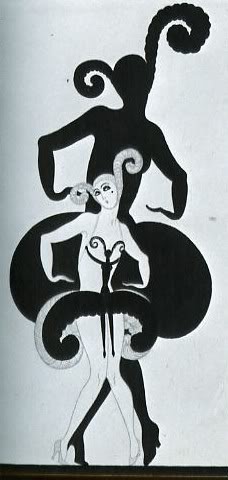
In "Charleston" for George White's "Sandals" , both the shape of the costume and its shadow make the most of the angular motions of the dance.
“Not even Madonna rivals this effeminate, utterly elegant little character; in career longevity and creative output…she’s only going on silver! His autobiography showed him to be a fierce, fearless, live-and-let-live type, a man who loved nothing more than his work, cats and solitude. He loved intensely, polishing off a ‘til –death-do-us-part that lasted 20 years and still left him ‘widowed’ in his mid-30s. He told the world about his life, art, love, theatre, opera, and Hollywood: his autobiography, Things I Remember, astonishes with dry, spare humour and deep warmth. Erte was a man of great refinement and absolute manners, hobnobbing with fashion designers and actresses, opera divas and prominent personalities- yet there’s no indication anywhere that he was ever a snob…”( Lorette C. Luzajic )
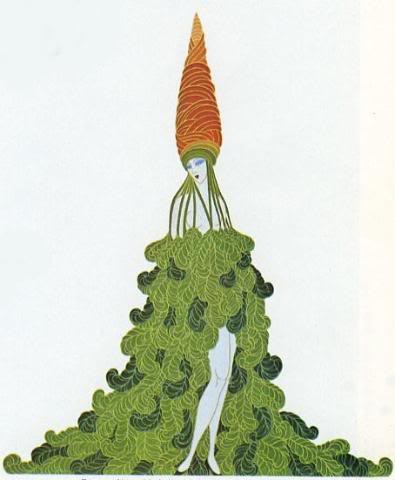
Soon after "Charleston" ,"Scandals" audiences were treated to the witty overflow of vegetation that characterizes the Carrot.
The 1920’s saw the spread of the revue form all over the world, and with it the introduction of new stars, among them the electrifying Josephine Baker, and new dances, like the Charleston and the Black Bottom. As one enthusiast put it, “The music hall has become , along with the cinema, the favorite spectacle of the world of 1928.” Erté was in his heyday. For the citizens of the world of 1928 at the Folies-Bergere in paris, or at George White,s “Scandals” in New York, Erté designed revue after revue: “The Triumphant Courtesan,” “The Queen of Sheba,” “Perfumes”, and “The Treasures of Indochina.” Like other designers of the Art Deco period, Erté was swept along by the fashion for all things Oriental, by the mania for Egyptian motifs that erupted after Tutankhamen’s tomb was opened in 1922, and by the discovery of African and American Indian art forms. Yet no matter what style or period he exploited, his work had its own fresh integrity. The “Queen of Sheba” might sound like cheap exoticism; in Erté’s hands it never looked it.
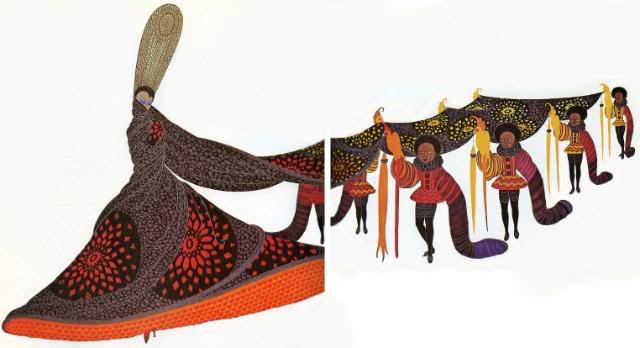
In the sartorial sobriety of 2010 it is pleasant to recall a time when display was what counted. Erté costume designs were concocted with one simple purpose in mind: dazzlement. In Guadalquivir, Erté started with nothing more than an ordinary Spanish dancer's costume. Then, by adding an exaggerated train, he deftly evoked the whole undulating length of a river.
For one thing, Erté was set apart from other theatre designers of the period by the quality of his finished designs. They are masterpieces of precision, their obsessive attention to detail reminiscent of the Persian miniatures or Russian icons. The pearls that he paints, for example, are miniscule raised pinpoints of pigment, meticulously applied in layer after layer with a fine brush.
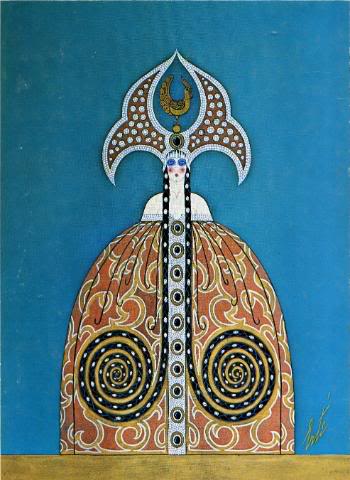
When Erté , dreamed up this fanciful b
t costume , it was not intended for dancing, but for dazzling. Glitter was what counted.From the beginning, Erté impressed the critics. When his costumes and sets first appeared in George White’s “Scandals” of 1922, his “strange and sophisticated art” was cited by one reviewer as the best part of the show. Of the “Scandals” of 1924 another wrote: “We do not expect to find a more ravishing spectacle this side of paradise.” Still, Erte’s work was not for everyone. The curmudgeonly critic for “The New Yorker”, Charles Brackett, described as follows an Erté-designed number from the “Scandals” of 1926 called “I Want a Tweet, Tweet, Tweetie Too,” a song sung by the two McCarthy sisters:
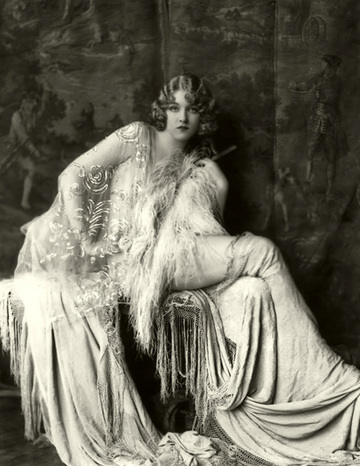
"I have always been so into the Ziegfeld girls...the dances, their lavish lifestyles, the "Backdoor Johnnies" who gave them jewels like candy, the fabulous Erte designed costumes they got to wear."
“When they’ve finished, great curtains part, revealing… a gigantic mother bird which, without ornithological authority, I should diagnose as a bird of paradise, obligingly seated on three ostrich eggs. After a frenzy of applause from the audience there emerge, from the center egg, fout down-colored baby bird girls, who are specialty dancers, and i can’t say how many other brilliantly hued and presumably mature bird-girls, which seems to me rather like overproduction for any one egg, no matter what its size.”
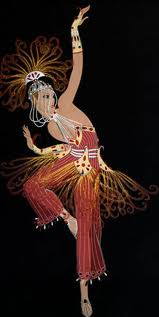
"Images created by Erté influenced dance costuming, both directly through his own designs, and indirectly by establishing the silhouettes, the "lines," the "dancerly look." His costume ideas have been emulated and echoed by dancers and dance theaters of all genres and styles -- ballet, modern, bellydancers, Las Vegas showgirls and drag queens. "
It hardly matters if the idea behind a revue was banal or even ridiculous. Whatever the dramatic validity, the effect must have been ravishing. In awe of Erté’s power to enchant, George Barbier said, “What an artistic and poetical joy to orchestrate these forms, to tune up these rhythms, and to harmonize those colors!”
Barbier was almost certainly influenced in his revue costumes by his more famous colleague, Erte, who also designed costumes for The Folies. Barbier composed the following description of Erte’s style for a catalogue of an exhibition of Erte’s work:
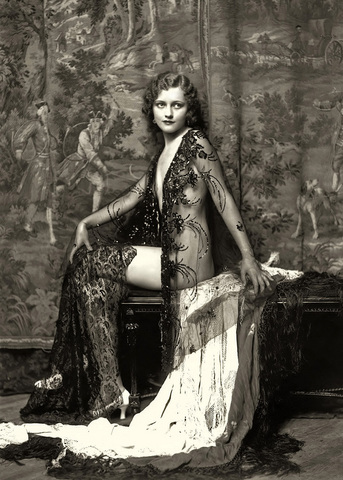
"In his 1975 autobiography, Things I Remember, Roman Petrovich Tyrtov - who the world knows as Erté - wrote: "I firmly believe that every human being has a duty to make himself as attractive as possible. Not many of us are born beautiful; that is why I have always attached so much importance to clothes. Clothes are a kind of alchemy; they can transform human beings into things of beauty or ugliness... Elegance is an innate quality, it cannot be acquired." Ziegfield Model. 1920's.
“I appreciate him above all when on the stage of the music-hall he brings out of the earth a network of diamonds throbbing on nude bodies, when he unfurls curtains embroidered with fantastic birds, or when again he raises curtains woven with ostrich feathers and heavy with fur, or harems afire, or on eastern cities built of snow, of nacre or metal. It is no easy task to wrench the blasâ spectator from his seat in the stalls or to carry him away on the magic carpet to a world of splendour…”
Today, long after the curtains have gone down, those of us who never saw Erté’s magic onstage can still enjoy his splendid visions on paper.
“Erte worked fearlessly, and he was blessed with strength and confidence and intuition. While the theatre world was long a haven for the queer, the early 1900s weren’t exactly an ideal era to burst out of the closet in. Will and Grace had not yet brought camp into everybody’s normal social circle. Madonna had not yet rolled out the red carpet. Furthermore, Erte was the only son of a Russian Imperial Fleet admiral. Still, his gayness must have been obvious even to those who had never known or heard of such a thing. Even as a child, Erte looked effeminate. He wanted to be a ballerina! He hated war passionately, unlike all the men in his bloodline who lived for their military duties. Erte had beauty, not violence, in his heart. “When I was five years old, I designed an evening dress for my mother,” he writes. Indeed, his mother had the gown made up, and wore it to a ball. “Around her décolletage was a garland or real roses. I was absolutely enchanted.” Surely the redder necked among us will point to such examples to say, see; it IS the mother’s fault! But most of us see that sublime moment for what it was – as Erte felt, the pivotal moment where his fate was realized. Every last piece of his work was a celebration of women’s exquisite beauty.”
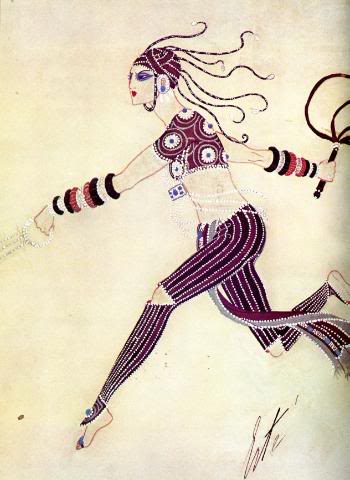
"The line of beauty is intrinsic to the nature laws. If you desire, go ahead for a fact-finding mission, let’s say, to the seashore. Sea shells which you’re going to study have the lines of beauty. When you enjoy the beautiful serpentine lines of Mucha, D’Erte or other artists, keep in mind they represent the lines of beauty that surround you in the nature, in other ladies or gentlemen, and in your own body"
“When speaking about influences on his art, D’Erte (Roman Tyrtov or Tirtoff) made a statement that the only influence he had been under could be reduced to medieval miniatures of India and Persia. Evidently, D’Erte himself believed in that assumption.
However, there is one common feature that unites the painters, graphic artists or designers within traditions of the art nouveau and art deco, and this feature is also intrinsic to the art of Roman Tirtoff. The feature is clearly visible: it is the line of beauty in its many versions.
The line of beauty was not an invention of the art nouveau movements. Attentive artists have been asking themselves about aspects of the beauty again and again. William Hogarth wrote a treatise titled as “The Analysis of Beauty” and published in 1753. He was proud of his independent finding, and that was the reason why he revealed the S-shaped line of beauty, or to be more precise, the serpentine line, on his palette in the self-portrait. Since then, the Line of Beauty has been discussed in many books on aesthetics.”
a


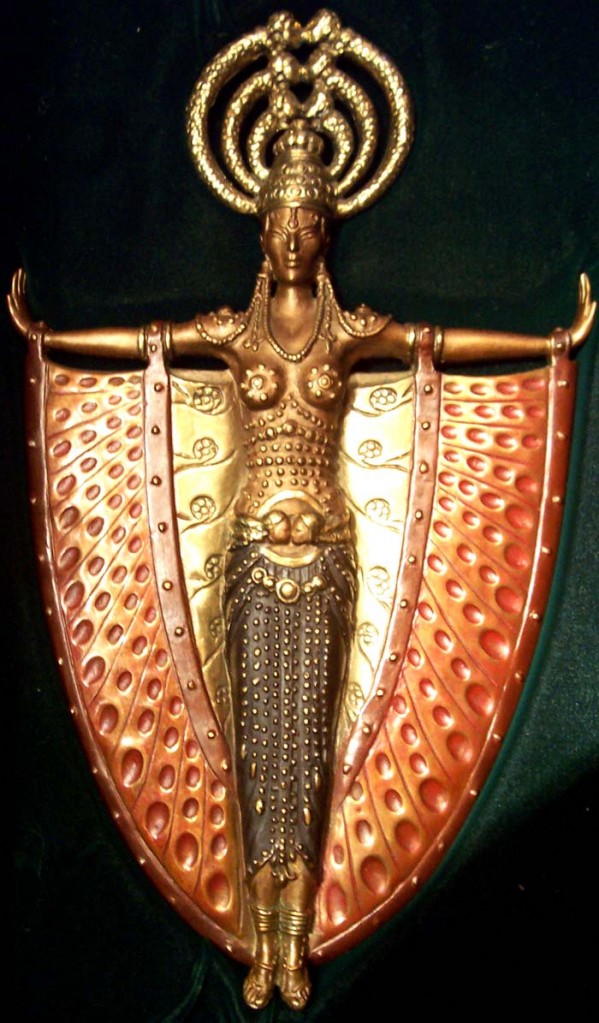



 COMMENTS
COMMENTS
The one and only Erte. Genius. I always felt he was an architect of fashion, an engineer. I get lost for hours following the lines of his drawings trying to imagine where one line starts and finishes and how and why (what was he thinking) in the process. His illustrations were phenomenal. The grace. The detail. The eye of a God. Thank God we have his work to look at today. Considering the frantic pace of life today and such TV shows as HGTV, the upcoming designers who have to cram their skills into 4-6 weeks of torture and be judged forever, and America’s Top Model where the young women are tortured at every twist and turn at a hair-raising pace, and a Hollywood that is quite lack-luster in every way compared to Erte’s time, today’s insta-fashion, short-lived trends, and profit driven industries, it is such a relief to look back now and then to see someone and some thing made from the head and the heart with time and care and passion. I wish America would return to seeking quality and release seeking quantity. I think no one will ever come close to Erte’s genius.
different time, different contexts. thanks for your comment!